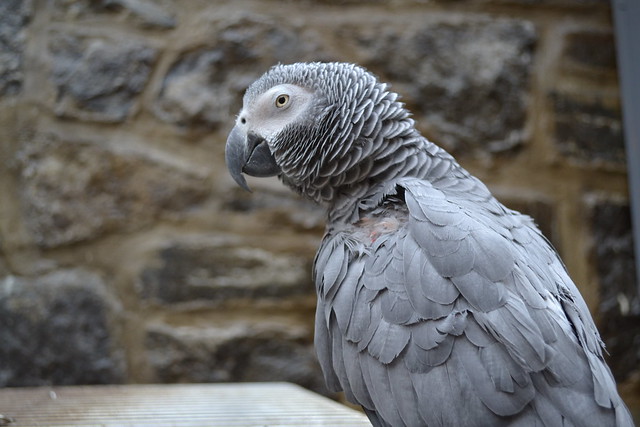some people want a pet that they can exercise and play with, and some people want a pet that will help keep them warm at night. Still other people want a companion -- an animal that will be an unquestioning, faithful friend through thick and thin. That's all good for them, but there are those of us who want a companion that we can talk to. We want a voice at the end of a long work day welcoming us home with, "Hello, darling, how was your day?" For people who wish to have that type of companion in the form of an animal, a talking bird fits the bill very nicely. However, not just any talking bird will do. Some birds speak quietly, while others will scream at the top of their lungs. The type of bird one chooses must be paired suitably with the environment in which one lives. That is, house or apartment, metropolitan or suburban. At any time of day. But, perhaps you live in the countryside and the only audio comfort that needs to be taken into consideration is your own. In that case, you will need to decide how much noise you can handle through the day. All talking birds are great fun to have as companions, but some are better at verbalizing and enunciating their words than others. Some species have better memory than others and are able to store hundreds, even thousands of words into their little bird brains. Then there are the select few, like the African Grey, that are able to listen to people talk, discern the proper context and situation, and hold a reasonable conversation (reasonable within the context of being a bird). There are even birds that will break out of their norm and surprise everyone with its highly capable memory and language skills. It is those extraordinary birds that are often showcased on shows like Animal Planet. For this list, we based our choices on the special abilities of species within the bird classes. Amazons, for example, are a large group, but only a handful are known for being talented with speech. And then there are some species that can talk, but they tend to be garbled, or they are known to spend more time screeching than

they do speaking. These species were not included.
(9) Budgerigar — The budgerigar (Melopsittacus undulatus), also known as common pet parakeet or shell parakeet and informally nicknamed the budgie, is a small, long-tailed, seed-eating
parrot. Their voice tends to be low and not always defined, and males tend to train better than females. Budgerigars are the only species in the
Australian genus Melopsittacus, and are found wild throughout the drier parts of
Australia where the species has survived harsh inland conditions for the last five million years.Budgerigars are naturally green and yellow with black, scalloped markings on the nape, back, and wings, but have been bred in captivity with colouring in blues, whites, yellows, greys, and even with small
crests. Budgerigars are popular pets around the world due to their small size, low cost, and ability to mimic human speech.
The origin of the budgerigar's name is unclear. The species was first recorded in 1805, and today is the most popular pet in the world after the domesticated dog and cat. The budgerigar is closely related to the
lories and the
fig parrots. They are one of the
parakeet species, a non-taxonomical term that refers to any of a number of small parrots with long, flat and tapered tails. In both captivity and the wild, budgerigars breed
opportunistically and
in pairs.
Source: Article.
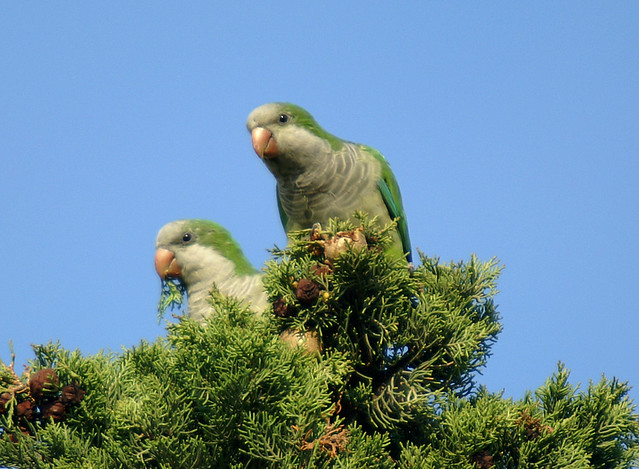 (8) Monk Parakeet —
(8) Monk Parakeet — Also called the Quaker Parakeet (Myiopsitta monachus), is a
species of
parrot, this colorful little bird is actually a small parrot. They are known for being very clever and social, developing large vocabularies of phrases and words. in most treatments the only member of the
genus Myiopsitta. It originates from the temperate to
subtropical areas of
Argentina and the surrounding countries in
South America. Self-sustaining
feral populations occur in many places, mainly in
North America and
Europe.
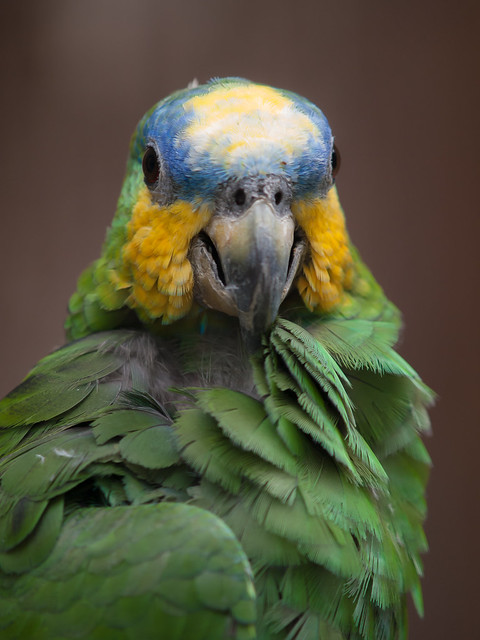 (7) Blue-Fronted Amazon
(7) Blue-Fronted Amazon — If you want a companion for life, this is a good fit. The Blue-Fronted can live for up to 100 years, or more. They have an excellent speaking voice, with a strong ability to mimic human voices. The Blue-fronted Amazon (Amazona aestiva), also called the Turquoise-fronted Amazon and Blue-fronted Parrot, is a
South American species of
Amazon parrot and one of the most common Amazon
parrots kept in captivity as a
pet or
companion parrot. Its common name is derived from the distinctive blue marking on its head just above its beak. The Blue-fronted Amazon is a mainly green parrot about 38 cm (15 in) long. They have blue feathers on the forehead above the beak and yellow on the face and crown. Distribution of blue and yellow varies greatly among individuals. Unlike most other Amazona parrots, its beak is mostly black. There is no overt sexual dimorphism in
plumage to the human eye, but analysis of the feathers using spectrometry, a method which allows the plumage to be seen as it would be by a parrot's tetrachromatic vision, shows clear differences between the plumage of the sexes. Juveniles of parrots are duller and have dark irises.
Source: Article
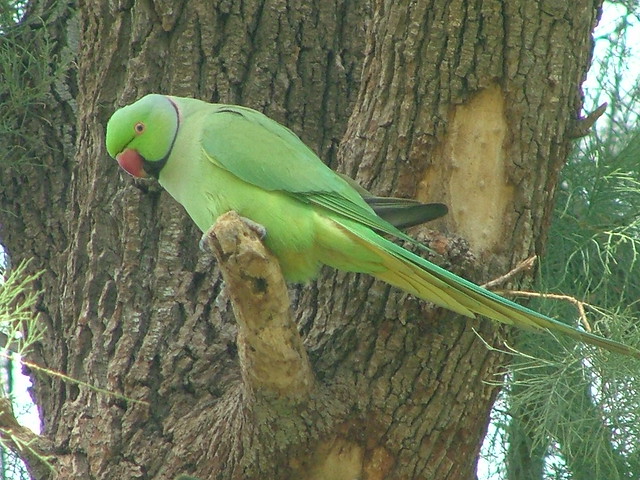 (6) Indian Ringneck —
(6) Indian Ringneck — Very clever little birds, Indian Ringnecks (Psittacula krameri), also known as the Ring-necked Parakeet, can develop a large vocabulary, and speak very clearly in sentences. Not so much for mimicking the pitch of a human voice, they more often speak in their own bird voices, though they can carry the mood of the phrase. It is a gregarious tropical Afro-Asian
parakeet species that has an extremely large range. Since the trend of the population appears to be increasing, the species was evaluated as
Least Concern by
IUCN in 2012.Rose-ringed parakeets are popular as pets. Its scientific name commemorates the Austrian
naturalist Wilhelm Heinrich Kramer.This
non-migrating species is one of few parrot species that have successfully adapted to living in 'disturbed habitats', and in that way withstood the onslaught of urbanisation and
deforestation. In the wild, this is a noisy species with an unmistakable squawking
call.
Source: Article
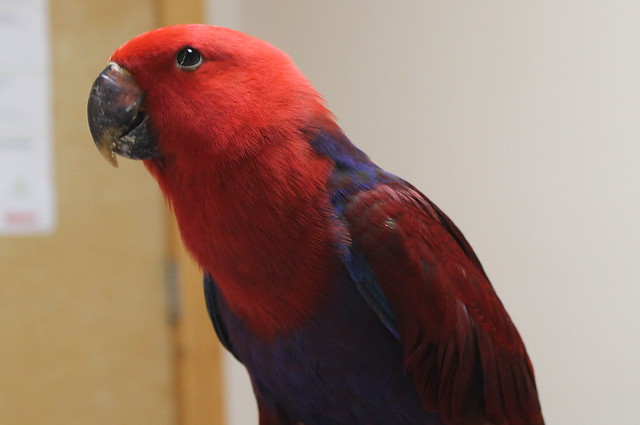 (5) Eclectus —
(5) Eclectus —The Eclectus Parrot (Eclectus roratus) is a
parrot native to the
Solomon Islands,
Sumba,
New Guinea and nearby islands, northeastern
Australia and the
Maluku Islands (Moluccas). this parrot is able to verbalize distinctly and mimic the tone and mood of language. While its capabilities are strong, these abilities depend entirely on training from an early age. It is unusual in the parrot family for its extreme
sexual dimorphism of the colours of the plumage; the male having a mostly bright emerald green plumage and the female a mostly bright red and purple/blue plumage.
Joseph Forshaw, in his book Parrots of the World, noted that the first European ornithologists to see Eclectus Parrots thought they were of two distinct species. Large populations of this parrot remain, and they are sometimes considered pests for eating fruit off trees. Some populations restricted to relatively small islands are comparably rare. Their bright feathers are also used by native tribes people in New Guinea as decorations.
Source: Article
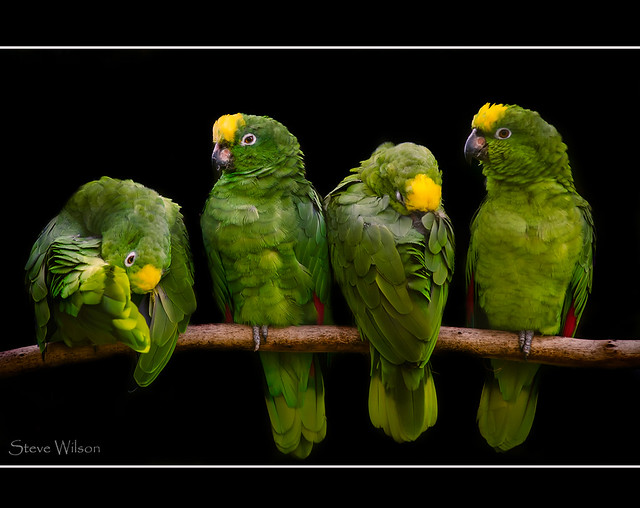 (4) Yellow-Crowned Amazon —
(4) Yellow-Crowned Amazon — Considered to be nearly as good as the Yellow-Naped, with less of a tendency to nip. The Yellow-crowned Amazon or Yellow-crowned Parrot (Amazona ochrocephala), is a species of
parrot, native to the tropical
South America and
Panama. The
taxonomy is highly complex, and the
Yellow-headed (A. oratrix) and
Yellow-naped Amazon (A. auropalliata) are sometimes considered
subspecies of the Yellow-crowned Amazon. have a total length of 33–38 cm (13–15 in). As most other
Amazon parrots, it has a short squarish tail and a primarily green
plumage. It has dark blue tips to the
secondaries and
primaries, and a red
wing speculum,
carpal edge (leading edge of the wing at the "shoulder") and base of the outer tail-feathers. The red and dark blue sections are often difficult to see when the bird is perched, while the red base of the outer tail-feathers only infrequently can be seen under normal viewing conditions in the wild. The amount of yellow to the head varies, with nominate, nattereri and panamensis having yellow restricted to the crown-region (occasionally with a few random feathers around the eyes, while the subspeciesxantholaema has most of the head yellow. All have a white eye-ring. They have a dark bill with a large horn or reddish spot on the upper mandible except panamensis, which has a horn coloured beak. Males and females do not differ in plumage. Except for the wing speculum,
juveniles have little yellow and red to the plumage.
Source: Article
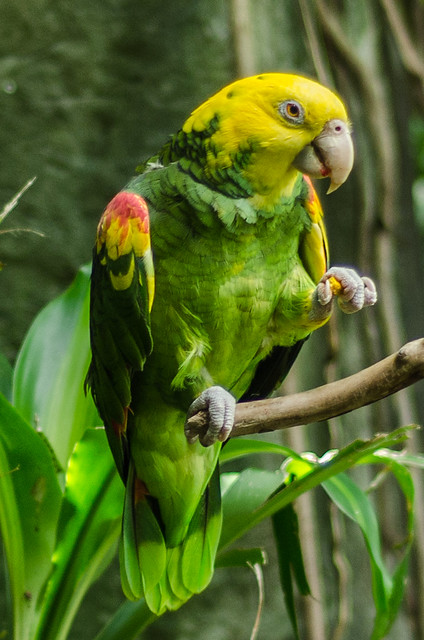 (3) Double Yellow Head Amazon —
(3) Double Yellow Head Amazon — The Yellow-headed Amazon (Amazona oratrix), also known as the Yellow-headed Parrot and Double Yellow-headed Amazon, is an
endangered amazon parrot of
Mexico and northern
Central America. Measuring 38–43 centimetres (15–17 in) in length, it is a stocky short-tailed green parrot with a yellow head. It prefers to live in mangrove forests or forests near rivers or other bodies of water. It is sometimes considered a
subspecies of the
Yellow-crowned Amazon. It is a popular
pet and an excellent talker.
Source: Article
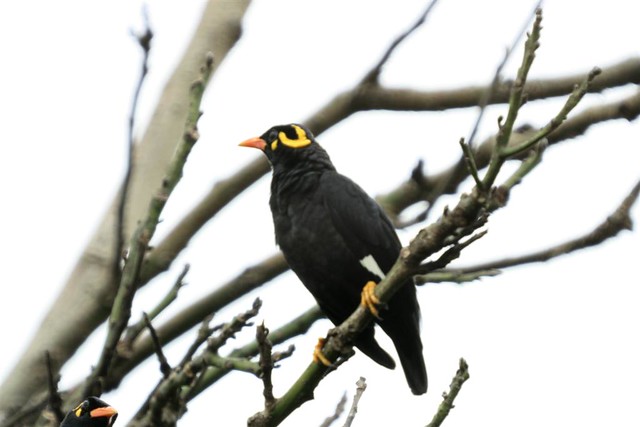
(2) Hill Myna — This pretty little black bird has an amazing capacity for mimicking human voices, with a varied range of pitch and tonality. The common hill myna (Gracula religiosa), sometimes spelled "mynah" and formerly simply known as hill myna, is the
myna bird most commonly seen in
aviculture, where it is often simply referred to by the latter two names. It is a member of the
starling family (Sturnidae), resident in hill regions of
South Asia and
Southeast Asia. The
Sri Lanka hill myna, a former
subspecies of G. religiosa, is generally accepted as a separate
species G. ptilogenys nowadays. The
Enggano hill myna (G. enganensis) and
Nias hill myna (G. robusta) are also widely accepted as specifically distinct, and many authors favor treating the southern hill myna (G. r. indica) from the
Nilgiris and elsewhere in the
Western Ghats of India as a separate species, also.
Source: Article
(1) African Grey — The African Grey is widely considered to be the smartest of the talking birds, and one of the most intelligent in the animal kingdom overall. Some experts say they approach the ability to speak and relate concepts on the level of a human toddler. Of the two standard "domesticated" species, the Timneh African Grey tends to learn to speak at a younger age than the Congo African Grey. The African Grey Parrot (Psittacus erithacus), also known as the Grey Parrot, is a
parrot found in the primary and secondary
rainforest of West and Central Africa. Experts regard it as one of the most
intelligent birds in the world. They feed primarily on palm nuts, seeds, fruits, and leafy matter, but have also been observed eating snails. Their overall gentle nature and their inclination and ability to mimic speech have made them popular pets, which has led many to be captured from the wild and sold into the pet trade. The African Grey Parrot is listed on
CITES appendix II, which restricts trade of wild-caught species because wild populations cannot sustain trapping for the pet trade.
Source: Articl-1-
2,
Images: flickr.com













